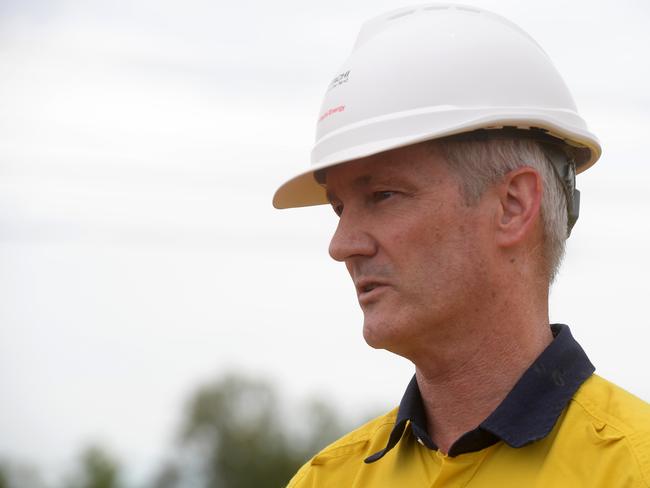Progress on Top End’s big battery project revealed
Work is well underway on the installation of the Top End’s big battery. Read how it will change the Territory’s power supply.
Business
Don't miss out on the headlines from Business. Followed categories will be added to My News.
Construction of the Territory’s $45m big battery is powering along, with civil and building works now complete ahead of connecting inverters, transformers and batteries to the Channel Island power network.
Chief Minister Natasha Fyles and Essential Services Minister Selena Uibo were at the site with Territory Generation chief executive Gerhard Laubscher on Monday to inspect work on the Darwin-Katherine Battery Energy Storage System (DK BESS) emission-busting project.
The 35MVA (megavolt amperes) battery is expected to reduce Territory emissions by about 58,000 tonnes a year.
About 20 people are currently working on the project including about 10 with Hitachi Energy who have the contract to install the technology.
Local companies City Earthmoving and T&M Concreters have done civil and foundation works for the project.
Hitachi Energy Country managing director Bernard Norton said the company’s virtual synchronous machine technology was key to replacing generators with battery.
“Hitachi have been in Northern Territory for over 30 years and it’s fantastic to be working with Territory Generation and this opportunity to replace the so-called spinning reserve,” Mr Norton said.

“This battery energy storage system will put about 35MW into the Darwin system.
“What it exactly does is replaces the gas turbines that are burning fossil fuels with clean, renewable, sustainable, reliable energy.
“The battery would power Darwin for about an hour and what that does is it gives the operators the opportunity to put some of that gas turbine equipment back into service should they need to do so in the event of a fault.
“It is a back-up and it’s about improving the reliability of the system but it also allows Territory Generation to install more renewable energy within that network as well. The battery energy storage system will store any energy that’s generated on the system so it will store solar and energy from the gas turbines.”
Ms Fyles said DK-BESS was important to achieving 50 per cent renewable power by 2030 and net-zero emissions by 2050.
“In the Northern Territory we’re in the privileged position where our power and water assets are owned by the NT Government and we can ensure Territorians have access to affordable electricity,” she said.
“We won’t see the price increases the east coast are facing – but we can also drive that shift to renewable energy.
“Territorians support sustainability and want clean energy and as a Government we’re delivering that.”
She said from a Government perspective some agencies including Health were “enormous” emitters.

“I know for example that as Health Minister, health is an enormous emissions contributor and that’s why we’ve recently advertised a position around director of sustainability and looking at that footprint and how we can deliver those important services but reduce our footprint.
“We’re really determined not only to have projects such as this where we have a battery, which means we can reduce the turbines spinning which is (reducing) fossil fuels to some of those departments that people wouldn’t think of as being big emitters and how we can reduce that carbon footprint.”
When operating, the battery is expected to service about 150,000 homes between Darwin and Katherine and save about $10m a year.
It is expected it will pay for itself within five years.
The big battery is expected to be operating in the first-half of next year.





